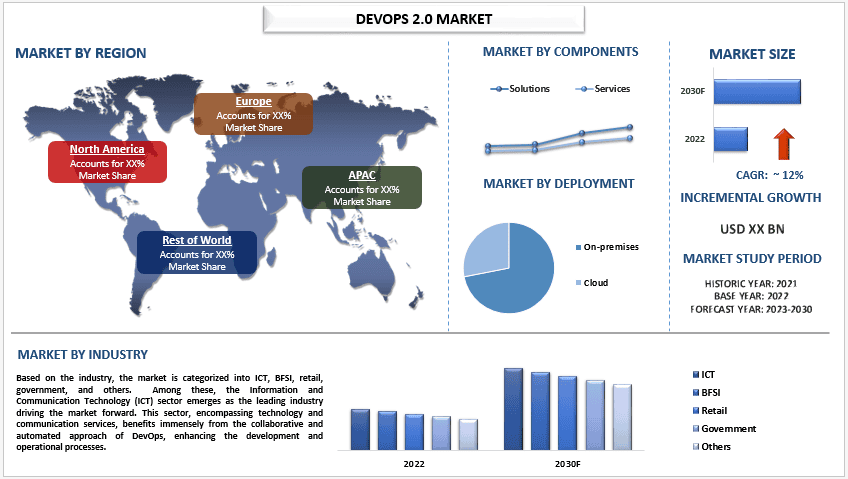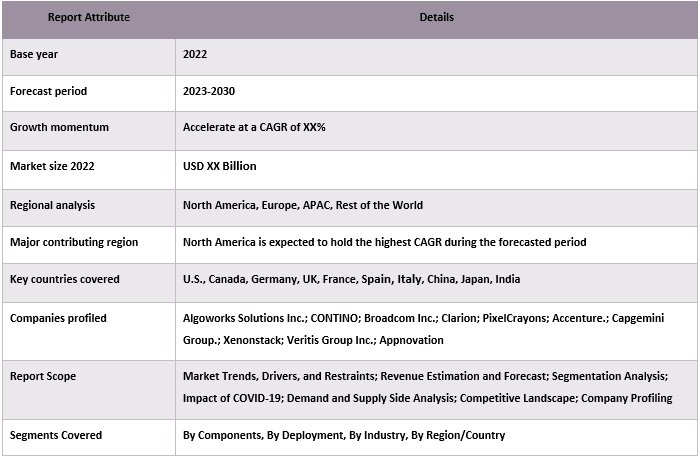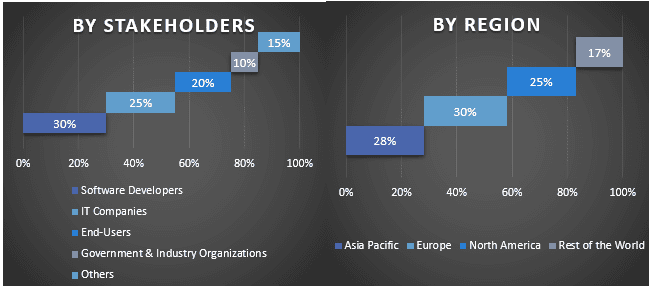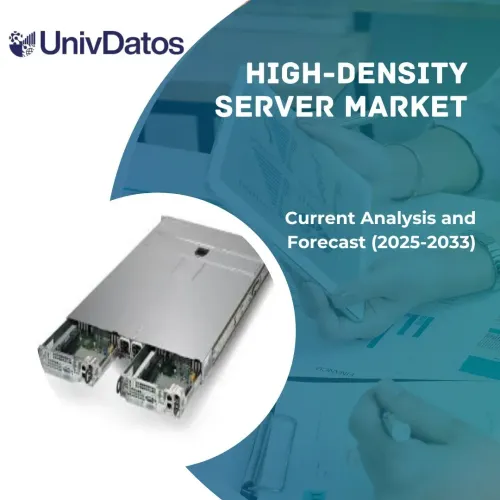- Strona główna
- O nas
- Branża
- Usługi
- Czytanie
- Kontakt
Rynek DevOps 2.0: Aktualna Analiza i Prognoza (2023-2030)
Nacisk na Komponenty (Rozwiązanie, [Narzędzia i Oprogramowanie] oraz Usługi); Wdrożenie (Lokalne i Chmura); Branża (ICT, BFSI, Handel Detaliczny, Administracja Publiczna i Inne) i Region/Kraj

Wartość Rynku DevOps 2.0 w 2022 roku wyniosła XX miliardów USD i oczekuje się, że w prognozowanym okresie (2023-2030) będzie rósł w stałym tempie około XX%, co wynika ze wzrostu zapotrzebowania na szybsze dostarczanie oprogramowania, ulepszoną współpracę między zespołami programistycznymi i operacyjnymi, automatyzację procesów tworzenia oprogramowania oraz wdrażanie technologii chmurowych.DevOps 2.0 rozszerza zasady DevOps na całą firmę, a nie tylko na zespoły programistyczne i IT. Zachęca do współpracy i jedności między różnymi działami, takimi jak QA, Security, Legal i HR, które współpracują przy tworzeniu, utrzymywaniu i ulepszaniu produktów oprogramowania. Ostatecznym celem DevOps 2.0 jest obalenie barier i promowanie otwartych kanałów komunikacji w całej organizacji w celu uzyskania lepszych wyników. Ponadto organizacje dążą do poprawy wydajności, skrócenia czasu wprowadzenia na rynek i poprawy ogólnej jakości oprogramowania poprzez wdrożenie praktyk DevOps. Ponadto rosnące zainteresowanie ciągłą integracją/ciągłym wdrażaniem (CI/CD), konteneryzacją i architekturą mikrousług przyczynia się do dynamiki na rynku DevOps 2.0.Na przykład, według raportu Puppet’s State of DevOps, około 80% organizacji rozpoczęło wdrażanie praktyk DevOps.
Niektórzy z głównych graczy działających na rynku to Algoworks Solutions Inc.; CONTINO; Broadcom Inc.; Clarion; PixelCrayons; Accenture.; Capgemini Group.; Xenonstack; Veritis Group Inc.; Appnovation.
Informacje Przedstawione w Raporcie
„Wśród komponentów, segment rozwiązań generuje obecnie znaczny udział w rynku w okresie prognozy.”
W oparciu o komponenty, rynek jest podzielony na rozwiązania i usługi. Segment rozwiązań jest dalej podzielony na narzędzia i oprogramowanie. Wśród nich segment rozwiązań miał znaczny udział w globalnych przychodach rynkowych. Segment ten obejmuje narzędzia i oprogramowanie, które mają na celu usprawnienie i ulepszenie procesów DevOps dla organizacji. Rozwiązania te działają jako wszechstronny pakiet, który obejmuje różne aspekty DevOps, takie jak ciągła integracja, zautomatyzowane testowanie, wdrażanie i monitorowanie. Wykorzystując te rozwiązania, firmy mogą skutecznie zarządzać tworzeniem i operacjami oprogramowania, umożliwiając szybsze i bardziej niezawodne dostarczanie aplikacji i usług. Dzięki szeregowi funkcji i możliwości rozwiązania te umożliwiają organizacjom optymalizację przepływów pracy DevOps, poprawę współpracy między zespołami i ostatecznie wspieranie innowacji i elastyczności w cyklu życia rozwoju oprogramowania.
„Wśród wdrożeń, segment chmury obecnie przoduje w okresie prognozy.”
W oparciu o wdrożenie, rynek jest podzielony na lokalne i chmurowe. Wśród nich segment chmury wyłania się jako lider w kształtowaniu rynku. Wdrożenie w chmurze zajęło centralne miejsce ze względu na swoje wrodzone zalety w zakresie skalowalności, elastyczności i dostępności. Organizacje zmierzają w kierunku rozwiązań DevOps opartych na chmurze, aby wykorzystać moc zasobów na żądanie, umożliwiając szybki rozwój, testowanie i wdrażanie. Co więcej, DevOps w chmurze ułatwia współpracę między rozproszonymi zespołami, oferując scentralizowaną platformę dostępną z dowolnego miejsca, sprzyjając bardziej wydajnemu i opartemu na współpracy środowisku rozwoju i operacji. Ponieważ firmy nadal przyjmują transformację cyfrową, dominacja chmury na rynku DevOps 2.0 podkreśla jej kluczową rolę w napędzaniu innowacji i doskonałości operacyjnej.
„Ameryka Północna będzie miała znaczny udział w rynku.”
DevOps 2.0 odnotowuje dynamiczny wzrost i zwiększone zapotrzebowanie na rynku Ameryki Północnej. Firmy coraz częściej dostrzegają wartość usprawnionej współpracy między zespołami programistycznymi i operacyjnymi w celu poprawy dostarczania oprogramowania i ogólnej wydajności. Co więcej, nacisk na automatyzację, ciągłą integrację i ciągłe dostarczanie napędzał wdrażanie praktyk DevOps w Ameryce Północnej, gdzie organizacje starają się utrzymać konkurencyjność w szybko rozwijającym się krajobrazie technologicznym. Ponieważ firmy dążą do szybszego i bardziej niezawodnego wdrażania oprogramowania, zapotrzebowanie na wykwalifikowanych specjalistów DevOps i zaawansowane zestawy narzędzi wciąż rośnie, co czyni go kluczowym aspektem krajobrazu IT w regionie.
Zakres Raportu Rynku DevOps 2.0

Powody, dla których warto kupić ten raport:
- Badanie obejmuje analizę wielkości i prognoz rynku, zweryfikowaną przez uwierzytelnionych kluczowych ekspertów branżowych.
- Raport przedstawia szybki przegląd ogólnej wydajności branży na pierwszy rzut oka.
- Raport obejmuje dogłębną analizę wybitnych podmiotów z branży, ze szczególnym uwzględnieniem kluczowych danych finansowych przedsiębiorstw, portfolio produktów, strategii ekspansji i ostatnich wydarzeń.
- Szczegółowe badanie czynników napędzających, ograniczeń, kluczowych trendów i możliwości występujących w branży.
- Badanie kompleksowo obejmuje rynek w różnych segmentach.
- Dogłębna analiza regionalna branży.
Opcje Dostosowywania:
Globalny rynek DevOps 2.0 można dalej dostosować do wymagań lub jakiegokolwiek innego segmentu rynku. Poza tym, UMI rozumie, że możesz mieć własne potrzeby biznesowe, dlatego skontaktuj się z nami, aby uzyskać raport, który w pełni odpowiada Twoim wymaganiom.
Spis treści
Metodologia Badawcza dla Analizy Rynku DevOps 2.0
(2023-2030)
Analiza historycznego rynku, oszacowanie obecnego rynku i prognozowanie przyszłego rynku globalnego rynku DevOps 2.0 to trzy główne kroki podjęte w celu stworzenia i analizy adaptacji rynku DevOps 2.0 w głównych regionach na całym świecie. Przeprowadzono wyczerpujące badania wtórne w celu zebrania historycznych danych rynkowych i oszacowania obecnej wielkości rynku. Po drugie, aby zweryfikować te spostrzeżenia, wzięto pod uwagę liczne ustalenia i założenia. Ponadto przeprowadzono również wyczerpujące wywiady pierwotne z ekspertami branżowymi w całym łańcuchu wartości globalnego rynku DevOps 2.0. Po założeniu i walidacji danych rynkowych za pomocą wywiadów pierwotnych, zastosowaliśmy podejście odgórne/oddolne do prognozowania całkowitej wielkości rynku. Następnie zastosowano metody podziału rynku i triangulacji danych w celu oszacowania i analizy wielkości rynku segmentów i podsegmentów branży. Szczegółowa metodologia wyjaśniona poniżej:
Analiza Wielkości Rynku Historycznego
Krok 1: Dogłębne Badanie Źródeł Wtórnych:
Szczegółowe badanie wtórne przeprowadzono w celu uzyskania historycznej wielkości rynku DevOps 2.0 poprzez wewnętrzne źródła firmowe, takie jakraporty roczne i sprawozdania finansowe, prezentacje wyników, komunikaty prasowe itp.oraz źródła zewnętrzne, w tymczasopisma, wiadomości i artykuły, publikacje rządowe, publikacje konkurencji, raporty sektorowe, bazy danych stron trzecich i inne wiarygodne publikacje.
Krok 2: Segmentacja Rynku:
Po uzyskaniu historycznej wielkości rynku DevOps 2.0, przeprowadziliśmy szczegółową analizę wtórną w celu zebrania historycznych informacji rynkowych i udziałów dla różnych segmentów i podsegmentów dla głównych regionów. Główne segmenty zawarte są w raporcie jako komponenty, wdrożenie i branża. Przeprowadzono dalsze analizy na poziomie kraju w celu oceny ogólnego wdrażania modeli testowania w tym regionie.
Krok 3: Analiza Czynników:
Po uzyskaniu historycznej wielkości rynku różnych segmentów i podsegmentów, przeprowadziliśmy szczegółowąanalizę czynnikóww celu oszacowania obecnej wielkości rynku DevOps 2.0. Ponadto przeprowadziliśmy analizę czynników przy użyciu zmiennych zależnych i niezależnych, takich jak różne komponenty, wdrożenie i rynek branżowy DevOps 2.0. Przeprowadzono dokładną analizę scenariuszy popytu i podaży, biorąc pod uwagę najważniejsze partnerstwa, fuzje i przejęcia, ekspansję biznesową i wprowadzenia produktów w sektorze rynku DevOps 2.0 na całym świecie.
Szacowanie i Prognoza Obecnej Wielkości Rynku
Szacowanie Obecnej Wielkości Rynku:W oparciu o praktyczne spostrzeżenia z powyższych 3 kroków, doszliśmy do obecnej wielkości rynku, kluczowych graczy na globalnym rynku DevOps 2.0 i udziałów rynkowych segmentów. Wszystkie wymagane udziały procentowe, podziały i podziały rynku zostały określone przy użyciu wspomnianego powyżej podejścia wtórnego i zostały zweryfikowane za pośrednictwem wywiadów pierwotnych.
Szacowanie i Prognozowanie:Do oszacowania i prognozowania rynku przypisano wagi do różnych czynników, w tym czynników napędzających i trendów, ograniczeń i możliwości dostępnych dla interesariuszy. Po przeanalizowaniu tych czynników zastosowano odpowiednie techniki prognozowania, tj. podejście odgórne/oddolne, aby uzyskać prognozę rynkową na 2030 r. dla różnych segmentów i podsegmentów na głównych rynkach na całym świecie. Metodologia badawcza przyjęta do oszacowania wielkości rynku obejmuje:
- Wielkość rynku branży pod względem przychodów (USD) i wskaźnik adopcji Rynku DevOps 2.0 na głównych rynkach krajowych
- Wszystkie udziały procentowe, podziały i podziały segmentów i podsegmentów rynku
- Kluczowi gracze na globalnym rynku DevOps 2.0 pod względem oferowanych produktów. Ponadto strategie wzrostu przyjęte przez tych graczy w celu konkurowania na szybko rozwijającym się rynku.
Walidacja Wielkości i Udziału w Rynku
Badania Pierwotne:Przeprowadzono dogłębne wywiady z Kluczowymi Liderami Opinii (KOL), w tym z Kierownictwem Najwyższego Szczebla (CXO/Wiceprezesi, Szef Sprzedaży, Szef Marketingu, Szef Operacyjny, Szef Regionalny, Szef Krajowy itp.) w kluczowych regionach. Wyniki badań pierwotnych zostały następnie podsumowane, a analiza statystyczna została przeprowadzona w celu udowodnienia postawionej hipotezy. Dane z badań pierwotnych zostały skonsolidowane z ustaleniami wtórnymi, przekształcając tym samym informacje w użyteczne wnioski.
Podział Uczestników Pierwotnych w Różnych Regionach

Inżynieria Rynku
Zastosowano technikę triangulacji danych w celu ukończenia ogólnej estymacji rynku i uzyskania precyzyjnych danych statystycznych dla każdego segmentu i podsegmentu globalnego rynku DevOps 2.0. Dane zostały podzielone na kilka segmentów i podsegmentów po przestudiowaniu różnych parametrów i trendów w obszarach komponentów, wdrożeń i branż na globalnym rynku DevOps 2.0.
Główny cel badania globalnego rynku DevOps 2.0
W badaniu wskazano obecne i przyszłe trendy rynkowe globalnego rynku DevOps 2.0. Inwestorzy mogą uzyskać strategiczne spostrzeżenia, aby oprzeć swoje decyzje inwestycyjne na analizie jakościowej i ilościowej przeprowadzonej w badaniu. Obecne i przyszłe trendy rynkowe określiły ogólną atrakcyjność rynku na poziomie regionalnym, zapewniając platformę dla uczestników branżowych do wykorzystania niewykorzystanego rynku w celu czerpania korzyści z przewagi pierwszego ruchu. Inne cele ilościowe badań obejmują:
- Analizę obecnej i prognozowanej wielkości rynku DevOps 2.0 pod względem wartości (USD). Ponadto analiza obecnej i prognozowanej wielkości rynku dla różnych segmentów i podsegmentów.
- Segmenty w badaniu obejmują obszary komponentów, wdrożeń i branż.
- Definicja i analiza ram regulacyjnych dla branży rynku DevOps 2.0.
- Analiza łańcucha wartości związanego z obecnością różnych pośredników, wraz z analizą zachowań klientów i konkurentów w branży.
- Analiza obecnej i prognozowanej wielkości rynku DevOps 2.0 dla głównych regionów.
- Główne kraje regionów objętych badaniem obejmują Azję i Pacyfik, Europę, Amerykę Północną i Resztę Świata.
- Profil firmy na rynku DevOps 2.0 i strategie wzrostu przyjęte przez graczy rynkowych w celu utrzymania się na szybko rozwijającym się rynku.
- Szczegółowa analiza branży na poziomie regionalnym
Najczęściej zadawane pytania FAQ
P1: Jaki jest aktualny rozmiar rynku i potencjał wzrostu globalnego rynku DevOps 2.0?
P2: Jakie są czynniki napędzające wzrost globalnego rynku DevOps 2.0?
P3: Który segment ma największy udział w globalnym rynku DevOps 2.0 według branży?
P4: Który region zdominuje globalny rynek DevOps 2.0?
P5: Kim są kluczowi gracze działający na globalnym rynku DevOps 2.0?
Powiązane Raporty
Klienci, którzy kupili ten przedmiot, kupili również










